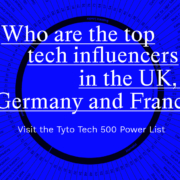Tyto dévoile la nouvelle édition de son rapport Tech 500 sur les influenceurs
En 2017, nous avions lancé la Tyto Tech 500 Power List dans le but d’identifier les personnalités les plus influentes du secteur technologique britannique et de comprendre ce qui crée réellement de l’influence. Puis en 2019, nous y avions inclus l’Allemagne, et l’année suivante la France, afin d’avoir un aperçu plus large des trois plus grandes économies d’Europe.
Aujourd’hui, alors que nous publions la 5e édition de notre rapport annuel Tech 500, notre évaluation objective de l’influence du secteur technologique européen est plus approfondie que jamais. Nous avons étoffé notre analyse des influenceurs en France en passant d’un Top 100 à un Top 500, comme dans les deux autres pays, et avons répertorié de nouvelles catégories Tech comme l’informatique quantique ou encore la SpaceTech.
Alors, qu’avons-nous appris au cours de cette cinquième année de réflexion et de recherche sur l’influence ?
Principaux résultats de la Tech 500 Power List 2021
Notre premier constat est que la GreenTech occupe désormais une place plus importante dans la liste européenne Tech 500, la GreenTech s’est hissée au quatrième rang des catégories les plus représentées, sur les 17 secteurs technologiques analysés.
Les questions environnementales demeurent un sujet majeur, au cœur de l’agenda politique, social et médiatique. De plus, la COP26 a vu les dirigeants mondiaux prendre des engagements et tenir des promesses historiques pour réduire les émissions de carbone et limiter le réchauffement climatique. Les nouvelles technologies joueront un rôle déterminant dans la concrétisation de ces engagements, ce qui explique la progression du nombre d’influenceurs GreenTech dans les classements des trois pays, cette année. Au Royaume-Uni, leur nombre a augmenté de 160 %, et en Allemagne de 47 %. Quant à la France, les influenceurs GreenTech sont passés de seulement 2 % du total à 6,4 %.
Notre deuxième constat porte sur la Covid-19 : la pandémie mondiale a rebattu les cartes de l’influence, et son impact est encore perceptible dans le rapport de cette année. Le développement et le déploiement réussis des vaccins (ainsi que l’émergence des nouveaux variants du virus) ont permis aux épidémiologistes, aux spécialistes de l’immunologie et aux autres experts de la santé de jouer un rôle essentiel dans la compréhension du Coronavirus.
En conséquence, les spécialistes de la BioTech et de la HealthTech ont vu leur influence croître de manière exponentielle. Des personnalités telles que Kate Bingham (ancienne responsable de la « UK Vaccine Taskforce »), Chris Whitty (médecin-chef de l’Angleterre) et Özlem Türeci (cofondatrice de BioNTech, ayant mis au point le premier vaccin approuvé contre la Covid-19) sont devenues quelques-unes des figures les plus influentes de l’année passée. En outre, les influenceurs BioTech dans le classement Tech 500 ont augmenté de 69 % et ceux de la HealthTech de 35 %. En 2021, un influenceur sur 10, dans le Top 500 à travers les trois pays, appartient à l’un de ces deux secteurs.
De la même manière, et en raison de la pandémie, l’influence des hommes politiques, des conseillers gouvernementaux et des universitaires a augmenté. Les citoyens ont sollicité les opinions de ces experts afin de comprendre le virus, ainsi que l’impact qu’aurait la levée des restrictions liées à la Covid-19 sur le nombre de cas. Ainsi, le nombre d’influenceurs de notre classement issus du secteur universitaire a progressé de 74,4 % et ceux du secteur gouvernemental de 57,1 %. En réalité, la plupart des premières places du classement européen sont occupées par des influenceurs gouvernementaux ou universitaires : 30 % des 100 premiers et 52 % des 25 premiers appartiennent à l’un de ces deux groupes.
Enfin, notre dernier constat est plus préoccupant : notre classement fait émerger une faible représentation des femmes influentes dans le secteur Tech européen. Seulement un influenceur sur cinq (22%) dans le top 500 européen est de sexe féminin. La France est le pays le moins diversifié avec le plus faible pourcentage de femmes dans le classement (11,1 % de l’ensemble des influenceurs français). L’Allemagne arrive devant avec une représentation de 19,2 % et le Royaume-Uni en tête avec la plus forte proportion de femmes (24,2 %) dans le Top 500 global.
Ce constat témoigne malheureusement du déséquilibre entre les sexes déjà existant dans le secteur. Cette disparité entre les sexes est largement rapportée, et Tyto cherche à y remédier par le biais de la Fondation Tyto et du travail avec la Charte des Talents Tech, en espérant observer une plus grande représentation féminine dans le rapport de l’année prochaine.
Pour en savoir plus sur les tendances du paysage des influenceurs Tech en Europe, téléchargez le rapport complet. Vous y trouverez également le classement global des 100 personnes les plus influentes en Europe ainsi que les top 100 des principaux influenceurs Tech de chaque pays.
Zoë Clark, Senior Partner et Responsable Médias et Influence chez Tyto









